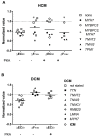Cardiomyopathies and Related Changes in Contractility of Human Heart Muscle
- PMID: 30065175
- PMCID: PMC6121228
- DOI: 10.3390/ijms19082234
Cardiomyopathies and Related Changes in Contractility of Human Heart Muscle
Abstract
About half of hypertrophic and dilated cardiomyopathies cases have been recognized as genetic diseases with mutations in sarcomeric proteins. The sarcomeric proteins are involved in cardiomyocyte contractility and its regulation, and play a structural role. Mutations in non-sarcomeric proteins may induce changes in cell signaling pathways that modify contractile response of heart muscle. These facts strongly suggest that contractile dysfunction plays a central role in initiation and progression of cardiomyopathies. In fact, abnormalities in contractile mechanics of myofibrils have been discovered. However, it has not been revealed how these mutations increase risk for cardiomyopathy and cause the disease. Much research has been done and still much is being done to understand how the mechanism works. Here, we review the facts of cardiac myofilament contractility in patients with cardiomyopathy and heart failure.
Keywords: Ca2+-sensitivity; cardiomyopathy mutations; dilated cardiomyopathy; human heart muscle contractility; hypertrophic cardiomyopathy; length dependent activation; troponin phosphorylation.
Conflict of interest statement
The authors declare no conflict of interest.
Figures






References
Publication types
MeSH terms
Substances
Grants and funding
LinkOut - more resources
Full Text Sources
Other Literature Sources
Medical
Miscellaneous

